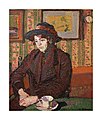Harold Gilman
Harold John Wilde Gilman | |
|---|---|
 Harold John Wilde Gilman pictured in the 1888 Abingdon School photograph. Gilman is on the bottom row, 4th from right. | |
| Born | 11 February 1876 |
| Died | 12 February 1919 (aged 43) |
Harold John Wilde Gilman (11 February 1876 – 12 February 1919) was a British painter of interiors, portraits and landscapes, and a founder-member of the Camden Town Group.
Early life and studies


Though born in Rode, Somerset, Gilman spent his early years at Snargate Rectory, in the Romney Marshes in Kent, where his father was the Rector. He was educated in Kent, Abingdon School in Berkshire, from 1885-1890,[1] in Rochester and at Tonbridge School, and for one year at Brasenose College in Oxford University.
Although he developed an interest in art during a childhood convalescence period, Gilman did not begin his artistic training until after his non-collegiate year at Oxford University (cut short by ill health) and after working in the Ukraine as a tutor to a British family in Odessa (1895). In 1896 he entered the Hastings School of Art to study painting, but in 1897 transferred to the Slade School of Fine Art in London, where he remained from 1897 to 1901, and where he met Spencer Gore. In 1904 he went to Spain and spent over a year studying Spanish masters (Velázquez and Goya as well as Whistler were major early influences).
Marriage
At this time he met and married the American painter Grace Cornelia Canedy. The couple settled in London (apart from a visit to her family in Chicago, when Gilman ducked pressure to join the Canedy family business). They had two daughters (one born in London, one in Chicago) and one son David born on 20 September 1908, at Letchworth Garden City in Hertfordshire. The family address at this time was 15 Westholm Green, Letchworth. Harold Gilman was married, for the second time, in the late summer of 1917 to Sylvia Hardy, an artist who had met at Westminster and she had studied with him since 1914.
Painting career
Meeting Walter Sickert in 1907, Gilman became a founder member of both the Fitzroy Street Group (in 1907) and the Camden Town Group (in 1911). In the meantime he joined the Allied Artists' Association, moved to Letchworth, and began to show influence from work of Vuillard as well as Sickert.

In 1910 he was stimulated by the first post-Impressionist exhibition at the Grafton Galleries, and visited Paris with Ginner. He soon outpaced Sickert's understanding of post-Impressionism and moved out from under his shadow, using ever stronger colour, under the influence of Van Gogh, Gaugin and Signac. In 1913 he exhibited jointly with Gore, and became the first president of the London Group; and identified with Charles Ginner as a 'Neo-Realist', exhibiting with Ginner under that label in 1914.
Gilman visited Scandinavia in 1912 and 1913, and may have travelled with the artist William Ratcliffe, who had relations there. Gilman made studies of the environment, and painted Canal Bridge, Flekkefjord, an accurate depiction, whose subject is likely to have been inspired by Vincent van Gogh's depiction of a similar bridge in Provence.[2] Gilman had rejected Van Gogh's work when he first encountered it, but later became a strong admirer and, according to Wyndham Lewis, keeping postcards of Van Gogh's work on his wall and sometimes hanging one of his own works next to them, if he was especially satisfied with it.[2]
In 1914 he joined Robert Bevan's short-lived Cumberland Market Group, with Charles Ginner and (later) John Nash. In 1915 the group held their only exhibition.
He taught at the Westminster School of Art where he influenced students who included Mary Godwin.[3] He then started his own school with Ginner.

In 1917 Gilman remarried.
In 1918 he was commissioned to travel to Nova Scotia by the Canadian War Records; and painted a picture of Halifax Harbour for the War Memorial at Ottawa.
He died in London on 12 February 1919, of the Spanish flu.
Legacy
Exhibitions were devoted to him at the Tate in 1954 and 1981, and he also featured in its 2007–2008 Camden Town Group retrospective at Tate Britain.
See also
Gallery
-
The Thames at Chelsea, 1899–1901
-
Clarissa, c. 1911
-
Sylvia Gosse, c. 1913
-
An Eating House, 1913/14
-
A Portrait in Profile: Mary L. Harold Gilman, 1914
-
Girl with a Tea Cup, c. 1914
-
Miss Ruth Doggett, c. 1915
-
Mother and Child, 1918
Notes and references
- ^ "Register". Abingdon School.
- ^ a b "Canal Bridge, Flekkefjord circa 1913", Tate. Retrieved 15 September 2008.
- ^ "Mary Godwin 1887-1960". Louise Kosman. Retrieved 8 July 2018.
Bibliography
- Helena Bonett, 'Harold Gilman 1876–1919', artist biography, October 2009, in Helena Bonett, Ysanne Holt, Jennifer Mundy (eds.), The Camden Town Group in Context, Tate, May 2012, http://www.tate.org.uk/art/research-publications/camden-town-group/harold-gilman-r1105360
- Robert Upstone, Modern Painters: The Camden Town Group, exhibition catalogue, Tate Britain, London, 2008 ISBN 1-85437-781-7
- Harold Gilman and William Ratcliffe, Southampton City Art Gallery, 2002
External links
- 65 artworks by or after Harold Gilman at the Art UK site
- Harold Gilman paintings at Tate Britain
- Harold Gilman at Grove Art Online
- Harold Gilman in the Dictionary of National Biography








